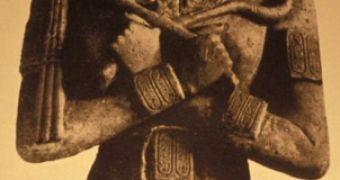The pharaoh Amenophis IV (1372-1354 BC) is most known amongst Egyptologists as the pharaoh who intended to introduce a monotheist religion in ancient Egypt. The cult of Aton (the solar disk) officially replaced Amon-Ra's cult. This was clearly an act of authority of the pharaoh, as priests considered the new orientation a heresy.
Amenophis IV, or Amenothes ("Amon is pleased") in Egyptian, adopted a royal name - Akhenaton (the one over whom the benevolence of Aton flows). But both the polytheist tradition (the faith in more than one god) of the Egyptians and the short rule of Akhenaton, of just 18 years, hampered the universal and longstanding installation of monotheism. Akhenaton and his wife Nefertiti built, in 1370 BC, the city of Ahet-Aton ("The Horizon of Aton"), today Tel el-Amaran, aimed to become the pan-Egyptian center of the cult of the new and unique god. Even if the monotheist cult of Aton did not survive after the death of Akhenaten, it seems that its echoes are found today in the Mosaic religion. Also, one of the psalms of the Old Testament is inspired from a hymn dedicated to Aton. The modern monotheist religions of Judaism, Christianity and Islam have something to do with this visionary pharaoh. Akhenaten was the father or half brother of Tutankhamun.
A new study presented at an annual conference held at the University of Maryland's School of Medicine has signaled that Akhenaten, despite the fact that he fathered at least 6 children, had a feminine body and was an egghead.
"The pharaoh's feminine mystique was the result of a genetic mutation that caused his body to convert more male hormones to female hormones than needed. Akhenaten's head was misshapen because of a condition in which skull bones fuse at an early age. He had a female physique with wide hips and breasts, but he was male and he was fertile and he had six daughters," said author Dr. Irwin Braverman, a physician at Yale University.
Braverman assesses the health of individuals based on portraits. In Akhenaten's case, he analyzed statues and carvings of him. He believes that Akhenaten suffered of Marfan Syndrome, a genetic conditioned characterized by lengthened features, like fingers and the face. "Others have theorized Akhenaten and his lineage had Froehlich's Syndrome, which causes feminine fat distribution, but also sterility. That doesn't fit Akhenaten, who had at least 6 daughters," said Braverman.
Klinefelter Syndrome, a chromosome condition that induces gynecomastia (male breast growth) has also been proposed, but other traits do not fit, and Braverman points towards less severe familial gynecomastia, a genetic condition caused by the excessive estrogen amounts. Determining which mummy is Akhenaten's and his DNA analysis could test all these theories.

 14 DAY TRIAL //
14 DAY TRIAL //